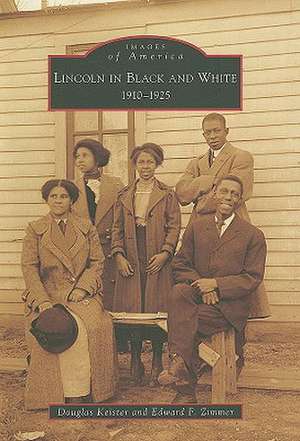Lincoln in Black and White: 1910-1925: Images of America (Arcadia Publishing)
Autor Douglas Keister, Edward F. Zimmeren Limba Engleză Paperback – 30 iun 2008
Din seria Images of America (Arcadia Publishing)
-
 Preț: 133.17 lei
Preț: 133.17 lei -
 Preț: 133.00 lei
Preț: 133.00 lei -
 Preț: 131.94 lei
Preț: 131.94 lei -
 Preț: 133.00 lei
Preț: 133.00 lei -
 Preț: 133.00 lei
Preț: 133.00 lei -
 Preț: 127.20 lei
Preț: 127.20 lei -
 Preț: 127.39 lei
Preț: 127.39 lei -
 Preț: 132.35 lei
Preț: 132.35 lei -
 Preț: 173.20 lei
Preț: 173.20 lei -
 Preț: 117.50 lei
Preț: 117.50 lei -
 Preț: 132.54 lei
Preț: 132.54 lei -
 Preț: 118.13 lei
Preț: 118.13 lei -
 Preț: 133.17 lei
Preț: 133.17 lei -
 Preț: 131.94 lei
Preț: 131.94 lei -
 Preț: 128.26 lei
Preț: 128.26 lei -
 Preț: 133.00 lei
Preț: 133.00 lei -
 Preț: 133.17 lei
Preț: 133.17 lei -
 Preț: 133.00 lei
Preț: 133.00 lei -
 Preț: 131.94 lei
Preț: 131.94 lei -
 Preț: 133.41 lei
Preț: 133.41 lei -
 Preț: 120.40 lei
Preț: 120.40 lei -
 Preț: 131.94 lei
Preț: 131.94 lei -
 Preț: 127.61 lei
Preț: 127.61 lei -
 Preț: 131.72 lei
Preț: 131.72 lei -
 Preț: 127.20 lei
Preț: 127.20 lei -
 Preț: 131.94 lei
Preț: 131.94 lei -
 Preț: 132.76 lei
Preț: 132.76 lei -
 Preț: 127.39 lei
Preț: 127.39 lei -
 Preț: 136.28 lei
Preț: 136.28 lei -
 Preț: 117.72 lei
Preț: 117.72 lei -
 Preț: 133.17 lei
Preț: 133.17 lei -
 Preț: 133.00 lei
Preț: 133.00 lei -
 Preț: 133.41 lei
Preț: 133.41 lei -
 Preț: 131.94 lei
Preț: 131.94 lei -
 Preț: 133.17 lei
Preț: 133.17 lei -
 Preț: 117.72 lei
Preț: 117.72 lei -
 Preț: 133.00 lei
Preț: 133.00 lei -
 Preț: 128.26 lei
Preț: 128.26 lei -
 Preț: 132.13 lei
Preț: 132.13 lei -
 Preț: 132.13 lei
Preț: 132.13 lei -
 Preț: 131.94 lei
Preț: 131.94 lei -
 Preț: 127.20 lei
Preț: 127.20 lei -
 Preț: 133.41 lei
Preț: 133.41 lei -
 Preț: 133.41 lei
Preț: 133.41 lei -
 Preț: 131.94 lei
Preț: 131.94 lei -
 Preț: 131.94 lei
Preț: 131.94 lei -
 Preț: 118.31 lei
Preț: 118.31 lei -
 Preț: 131.94 lei
Preț: 131.94 lei -
 Preț: 131.94 lei
Preț: 131.94 lei -
 Preț: 133.41 lei
Preț: 133.41 lei
Preț: 133.17 lei
Nou
Puncte Express: 200
Preț estimativ în valută:
25.48€ • 26.46$ • 21.25£
25.48€ • 26.46$ • 21.25£
Carte indisponibilă temporar
Doresc să fiu notificat când acest titlu va fi disponibil:
Se trimite...
Preluare comenzi: 021 569.72.76
Specificații
ISBN-13: 9780738561622
ISBN-10: 0738561622
Pagini: 128
Dimensiuni: 166 x 233 x 8 mm
Greutate: 0.32 kg
Editura: Arcadia Publishing (SC)
Seria Images of America (Arcadia Publishing)
ISBN-10: 0738561622
Pagini: 128
Dimensiuni: 166 x 233 x 8 mm
Greutate: 0.32 kg
Editura: Arcadia Publishing (SC)
Seria Images of America (Arcadia Publishing)
Descriere
Lincoln, Nebraska's capital, grew from 45,000 to 55,000 residents in the years 1910-1925. The state's second-largest city, Lincoln was also home to Nebraska's second-largest African American community--a "small town" within the midwestern city. Local race relations were a study in contradictions. Public education and residential neighborhoods were relatively integrated; employment and social institutions were increasingly restricted. Within this setting, a laborer named John Johnson--a native of Lincoln and son of a black Civil War veteran--produced remarkable images as an itinerant photographer of the Lincoln scene, especially of its black community. Johnson left very little written record, so knowledge is fragmentary of his working techniques and of his collaborators or assistants. But his visual legacy takes people through the streets, onto the front porches, and into the backyards and living rooms of a vibrant community.
Notă biografică
As a Lincoln youth interested in photography in the mid-1960s, Douglas Keister chanced upon and acquired over 250 negatives of Lincoln places and people--mostly African American people. He safeguarded the fragile glass plates as he developed a career in California as a professional photographer and author on photography, architecture, and history. In the 1990s, Lincoln's historic preservation planner Edward F. Zimmer began to encounter evocative photographs of Lincoln's early black community in research on local African American heritage. By combining Keister's negatives and the Lincoln research, a photographer's unique perspective on a community was again revealed.











